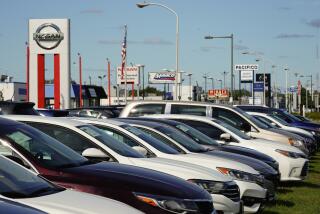More People Banking on Credit Unions : Better Interest Rates, New Services Lure Funds From Thrifts
- Share via
For 30 years, Antone J. Ratto banked happily at Bank of America. But two years ago, dissatisfied with its service and rates, Ratto pulled his accounts and put them into the credit union at Lockheed in Burbank.
Ratto now does most of his basic banking through the credit union. It has his individual retirement accounts, main checking and savings accounts and supplies his credit card. It even provides him with discount stock brokerage services.
“People at the credit union are nicer than at the bank,” said Ratto, 57, an employee benefits manager at Lockheed. “It’s a lot more personal feeling, the way banks used to be.”
Thanks to new business from customers like Ratto, credit unions are now among the nation’s fastest-growing financial service institutions, posing a rising competitive threat to banks and savings and loan firms.
Assets at the nation’s 16,660 credit unions have almost tripled this decade, to $177.3 billion at the end of April from $64.2 billion at the beginning of 1980. Credit union membership has grown to 55.2 million from 41.4 million in the same period.
To be sure, credit unions’ share of Americans’ savings still pales in comparison to the shares enjoyed by banks and S&Ls.; Credit unions account for 6.2% of U.S. household savings, up from 4.8% at the end of 1984 but still far short of the 47% and 35.1% shares at banks and S&Ls;, respectively.
Slower to Cut Rates
But the growth of credit unions has accelerated in recent years, amid a period of declining interest rates. By being slower to cut their interest rates on deposits, credit unions have attracted many savers unhappy with lower savings rates at banks.
Credit unions have also gained customers by generally charging lower rates and fees on credit cards and other services. Credit union checking accounts (called share drafts) often carry no monthly fees and no minimum balances, while banks typically charge monthly fees if balances fall below certain levels.
“Savers in credit unions have been getting a good deal,” said Bob Ilott, economist at the Credit Union National Assn., an industry trade group.
Credit unions are also gaining popularity because of their growing array of products and services. Once largely confined to offering traditional savings accounts and auto loans, many large credit unions now offer discount brokerage services, home and auto insurance, individual retirement accounts, small-business loans, home equity loans, credit cards, automated teller machines and even financial planning. For example, 15.5% of the nation’s credit unions provide credit cards, up from only 2% in 1981.
“They are beginning to look more like banks,” said John C. Rasmus, federal administrative counsel for the American Bankers Assn., which is concerned about credit unions’ incursion onto banks’ traditional turf.
Thanks to these diverse services, 42% of credit union members now use those institutions as their primary source of banking services, up from only 30% two years ago, according to a survey by the Credit Union National Assn.
Credit unions also gain adherents by tailoring services to the particular needs of their membership. The Los Angeles Teachers Credit Union, for example, is considering offering small-business loans and government-guaranteed student loans.
“Many teachers have businesses on the side,” Lee E. Travis, the credit union’s general manager and chief executive, said in explaining the demand for small-business loans. As for student loans, “teachers go to (college), so they like their kids to go, too.”
Credit unions are also gaining customers through aggressive and innovative marketing and membership drives. To gain auto loan customers, for example, many credit unions offer special sales. Local dealers bring new or used vehicles to one location, usually a local parking lot, offering discounts to credit union members with preapproved loans.
Credit unions have also been expanding membership eligibility to include workers from other companies or even members of outside social service, religious or civic organizations.
Alaska USA Federal Credit Union in Anchorage, the nation’s sixth-largest credit union, now provides its services to members of about 3,500 such organizations, including the Kodiak Swim Club. Many organizations, ranging from the American Assn. of Retired Persons to the Aid Assn. of Lutherans in Appleton, Wis., now have their own credit unions.
Smaller credit unions, meanwhile, are merging into bigger credit unions, providing members of the smaller institutions with access to more services. Accordingly, the number of credit unions has declined while membership and assets continue to grow.
But the credit union boom has not come without growing pains.
Deposits Top Loans
Perhaps the biggest problem is what to do with all the new deposits. Growth in credit union loans--which generates income to pay dividends on deposits--has not kept up with growth in deposits. The reason: Credit unions’ most popular loan product, auto loans, have been losing market share to auto company finance companies, such as General Motors Acceptance Corp., that offer cut-rate incentive programs.
That has forced credit unions to make an increasing proportion of small-business loans, mortgages or other loans that, unfortunately, have gone sour at a higher rate than auto loans. Several credit unions in Texas, Oklahoma and other Midwestern states have seen dramatic rises in delinquencies on small-business loans for members who put the money into oil drilling or farming.
To limit riskier lending by credit unions, the National Credit Union Administration, the agency regulating federal credit unions, has issued more restrictive rules governing commercial lending.
Credit unions have also coped with the auto loan squeeze by placing funds in bank certificates of deposit, mortgage-backed securities or other relatively safe, interest-earning investments. But these investments generally earn less than auto loans.
To compensate for higher loan delinquencies and lower investment returns, many credit unions are boosting rates and fees on their own loans to members, or cutting dividends (interest payments) on members’ deposits. But such moves “contain lots of risks,” said Joe Perkowski, chairman of the Credit Union National Assn. and president of Minneapolis Federal Credit Union. “You can drive people out the door.”
Credit unions face another, potentially more troubling problem: possible loss of their exemption from federal income tax. That exemption, which gives credit unions a major advantage over banks and other profit-oriented financial institutions, is among several business tax breaks that Congress is considering eliminating to raise revenue and cut the bloated federal budget deficit.
“Credit unions are doing everything commercial banks are doing,” Kirk Willison, a spokesman for the American Bankers Assn., said in arguing for elimination of the credit unions’ tax break. “So (they) ought to be competing on the same basis.”
But even if credit unions lose their tax-free status--which is unlikely--they still have other advantages over banks:
They enjoy lower costs stemming from low rent and free advertising provided by employer sponsors. Credit union members often deposit funds through payroll deduction plans, reducing costs of collection and handling. Most credit unions also do not have expensive branch networks, and their executives earn lower salaries than their bank counterparts. Credit union directors are prohibited by law from being paid. And, because they exist to serve members rather than to generate profits for shareholders, credit unions do not need to have higher fees or loan rates to ensure strong profit margins.
Credit unions may hold another important advantage: more personalized service. Depositors, angered by what they say is deteriorating customer service at many banks, are jumping on the credit union bandwagon. A recent survey by Concepts in Marketing Research of Minneapolis showed that 93% of credit union members surveyed said the quality of services equals or exceeds that of other financial institutions.
“I was unhappy with the service I was getting,” Janie Howe, 47, a department store sales clerk from Chatsworth, said of her former bank. She pulled her checking, savings and credit card business from the bank and gave it to a credit union. “I have no problems with the credit union,” she said.
“How many CEOs (of big banks) talk to their customers?” asked Travis of the Los Angeles Teachers Credit Union. “I do.”
Credit unions are rapidly eliminating one of their primary disadvantages compared to banks: an inadequate range of services.
Their growing product diversity is exemplified by Lockheed Federal Credit Union, California’s sixth-largest credit union. “We were a dinosaur,” marketing director Joe Schroeder said of the way the institution was four years ago. “We were relatively large, but we were slow-moving.”
Not any more. The credit union’s total assets have more than doubled in four years, thanks to new products and services.
Bargain Credit Cards
Lockheed credit union members can now get a Visa credit card charging 16% interest with no annual fee--a better deal than those offered by most banks. They can get home improvement loans, home equity loans, or first or second mortgages. They can withdraw cash at about 6,000 automated teller machines nationwide, thanks to the credit union’s membership in two nationwide ATM networks. Also, members can buy auto and homeowners insurance through a subsidiary of the credit union.
And they can buy stocks and mutual funds through a discount brokerage service offered by Olde Discount Brokerage. Lockheed credit union customers must now call the discount brokerage’s main office in Detroit to trade stocks or other investments. But eventually Olde Discount Brokerage will set up a broker-agent at the credit union’s main office in Burbank, once the number of accounts grows large enough to justify it, Lockheed credit union official Schroeder said.
Ratto, the Lockheed manager who switched his accounts to the credit union two years ago, said banks could learn from the responsiveness of the credit union.
“Banks could learn a lot (from credit unions) about how to deal with individuals,” he said. “They’re finding out that the individual is pretty important.”
THE NATION’S 10 LARGEST CREDIT UNIONS
Name Navy Federal CU, Washington, D.C. United Air Lines Employees CU, Chicago State Employees CU, Raleigh, N.C. Pentagon Federal CU, Alexandria, Va. Boeing Employees CU, Seattle Alaska USA Federal CU, Anchorage Hughes Aircraft Employees Federal CU, Manhattan Beach Eastern Airlines Employees Federal CU, Miami American Airlines Employees Federal CU, Dallas-Fort Worth IBM Poughkeepsie Employees Federal CU, Poughkeepsie, N.Y.
Name Assets in millions Navy Federal CU, Washington, D.C. $2,619 United Air Lines Employees CU, Chicago 1,521 State Employees CU, Raleigh, N.C. 1,331 Pentagon Federal CU, Alexandria, Va. 1,327 Boeing Employees CU, Seattle 784 Alaska USA Federal CU, Anchorage 733 Hughes Aircraft Employees Federal CU, Manhattan Beach 724 Eastern Airlines Employees Federal CU, Miami 718 American Airlines Employees Federal CU, Dallas-Fort Worth 658 IBM Poughkeepsie Employees Federal CU, Poughkeepsie, N.Y. 547
CALIFORNIA’S 10 LARGEST CREDIT UNIONS
Name Hughes Aircraft Employees Federal CU, Manhattan Beach Lockheed Missiles & Space Co. Federal CU, Sunnyvale Telephone Employees CU of Southern California, Pasadena Orange County Teachers Federal CU, Santa Ana The Golden 1 CU, Sacramento Lockheed Federal CU, Burbank Provident Central CU, Burlingame North Island Federal CU, San Diego Travis Federal CU, Vacaville McDonnell Douglas West Federal CU, Torrance
Name Assets in millions Hughes Aircraft Employees Federal CU, Manhattan Beach $724 Lockheed Missiles & Space Co. Federal CU, Sunnyvale 534 Telephone Employees CU of Southern California, Pasadena 528 Orange County Teachers Federal CU, Santa Ana 483 The Golden 1 CU, Sacramento 473 Lockheed Federal CU, Burbank 463 Provident Central CU, Burlingame 327 North Island Federal CU, San Diego 298 Travis Federal CU, Vacaville 289 McDonnell Douglas West Federal CU, Torrance 284
More to Read
Inside the business of entertainment
The Wide Shot brings you news, analysis and insights on everything from streaming wars to production — and what it all means for the future.
You may occasionally receive promotional content from the Los Angeles Times.










